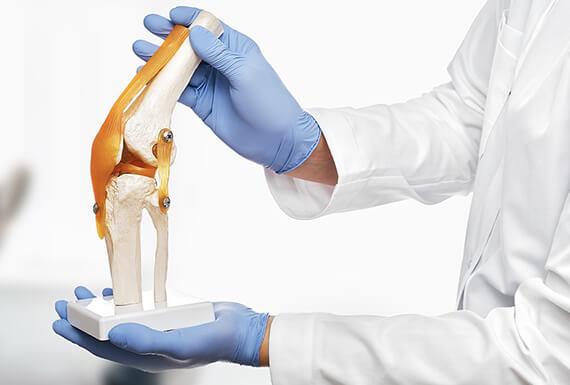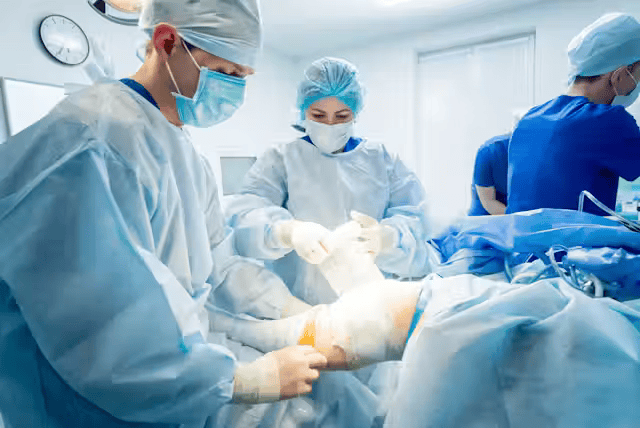Orthopaedic surgery


Fracture and Trauma Surgery
These operations tackle bone breaks and damages, which may occur due to trauma, falls, or mishaps.
- Fracture Fixation Surgery: Operative methods to support and reposition fractured bones, employing instruments such as plates, screws, pins, or rods.
- Internal Fixation: Placement of screws, plates, or rods to secure the bones in alignment.
- External Fixation: Utilization of outer frames or supports to reinforce bones externally.
- Open Reduction and Internal Fixation (ORIF): A method in which the bone is repositioned (reduced) and stabilized using internal fixation devices.
- Fracture Repair: Surgical interventions to fix intricate fractures that cannot be addressed with casting alone, such as those in the hip, pelvis, or spine.
- Joint Dislocation Surgery: Correction of dislocated joints (such as hip, shoulder, or knee) via reduction and stabilization.
Joint Replacement (Arthroplasty)
Joint replacement entails substituting a harmed joint with a synthetic one, typically in instances of profound arthritis, injury, or deterioration.
- Hip Replacement (Hip Arthroplasty): Extraction of an impaired hip joint and substitution with an artificial hip.
- Total Hip Replacement (THR): Complete substitution of the hip joint, encompassing the femoral head and acetabulum.
- Hip Resurfacing: A minimally invasive option for total hip replacement in which a metal prosthesis is placed on the femoral head.
- Knee Replacement (Knee Arthroplasty): Extraction of a faulty or aged knee joint and substitution with a synthetic knee.
- Total Knee Replacement (TKR): Substitution of the complete knee joint with an artificial device.
- Partial Knee Replacement (PKR): Substitution of solely the impaired section of the knee joint.
- Shoulder Replacement (Shoulder Arthroplasty): Substitution of an injured shoulder joint, usually as a result of arthritis or issues with the rotator cuff.
- Total Shoulder Replacement: Substitution of both the ball (humeral head) and the socket (glenoid).
- Reverse Shoulder Replacement: A targeted technique for individuals with rotator cuff arthritis, involving the exchange of the ball and socket.
- Elbow Replacement (Elbow Arthroplasty): Substitution of a harmed elbow joint, typically resulting from arthritis or injury.
- Ankle Replacement (Ankle Arthroplasty): Surgical substitution of an impaired ankle joint, usually due to advanced arthritis or a break.
Arthroscopy (Minimally Invasive Surgery)
Arthroscopic surgery is a minimally invasive procedure that employs tiny incisions and a camera (arthroscope) to identify and address joint issues.
- Knee Arthroscopy: A method for addressing knee issues like meniscus tears, ligament damages (such as ACL injuries), or cartilage harm.
- Shoulder Arthroscopy: Utilized for addressing issues such as rotator cuff injuries, labral injuries, or impingement syndrome.
- Hip Arthroscopy: A slightly invasive technique for addressing hip labral tears,femoroacetabularimpingement (FAI), along with various other hip joint issues.
- Wrist Arthroscopy: Employed to identify and manage issues such as wrist ligament damage, arthritis, or cartilage disorders.
- Ankle Arthroscopy: Conducted to address issues such as ankle sprains, tendonitis, or arthritis.
Spine Surgery
Surgical procedures on the spine tackle issues associated with the spinal column, such as degenerative disorders, broken bones, and malformations.
- Spinal Fusion: The surgical fusion of two or more vertebrae to restrict movement, typically carried out for issues such as degenerative disc disease, scoliosis, or spondylolisthesis.
- Discectomy: Elimination of a herniated or injured disc in the vertebral column, frequently performed to address sciatica or various nerve compression signs.
- Laminectomy: Excision of a portion of the vertebra (the lamina) to alleviate pressure on the spinal cord or nerves, frequently due to spinal stenosis or herniated discs.
- Spinal DecompressionSurgical techniques aimed at alleviating pressure on the spinal cord or nerves, which may include laminectomy,foraminotomy, or discectomy.
- Vertebroplasty/Kyphoplasty: Methods employed to address compression fractures in the backbone, usually resulting from osteoporosis, by injecting cement into the affected vertebra.
- Scoliosis Surgery: Surgical adjustment of irregular spine alignment (scoliosis), typically carried out using rods, screws, and various stabilizing instruments.
- Artificial Disc Replacement: Substitution of a harmed disc in the spinal column with an artificial one, typically carried out in the lumbar or cervical areas.
Ligament and Tendon Surgery
These operations are carried out to mend or rebuild ruptured or harmed ligaments and tendons.
- Anterior Cruciate Ligament (ACL) Reconstruction: Surgical reconstruction of the ruptured ACL in the knee, usually utilizing a graft from the patient’s own tissue or from a donor.
- Rotator Cuff Surgery: Surgical restoration of damaged rotator cuff tendons in the shoulder, which can be performed through arthroscopy or via open surgical techniques.
- Achilles Tendon RepairSurgical correction of a damaged or broken Achilles tendon.
- Ulnar Collateral Ligament (UCL) Repair (Tommy John Procedure): A method to repair the damaged UCL in the elbow, frequently carried out on sports players (particularly baseball pitchers).
- Tendon Repair: Surgical procedure to fix damaged tendons in regions such as the wrist, elbow, or hand.
Surgery of the Hand and Upper Limb
Orthopedicprocedures concerning the hand, wrist, and upper limbs tackle a variety of issues, from injuries to long-term ailments.
- Carpal Tunnel Release: An operation aimed at reducing pressure on the median nerve in the wrist, frequently conducted for carpal tunnel syndrome.
- De Quervain’s Tenosynovitis Surgery: Relieving the tendons impacted by this issue, resulting in discomfort on the thumb side of the wrist.
- Trigger Finger Release: Surgical detachment of the tendon that results in a finger getting locked in a curved stance (trigger finger).
- Fracture Repair: Surgical intervention for fractured bones in the hands, wrists, or forearms, involving the application of plates, screws, and pins.
- Dupuytren’s Contracture Surgery: Treatment of a condition where the fingers bend toward the palm, often performed with fasciectomy (removal of affected tissue).
- Joint Replacement (Hand and Wrist): Partial or complete joint replacement in situations of serious arthritis or trauma in the fingers, thumb, or wrist.
Foot and Ankle Surgery
Procedures involving the foot and ankle address issues such as deformities, fractures, arthritis, and tendon damage.
- Ankle Arthroscopy: Less invasive surgical procedures for addressing ankle arthritis, impingement, or ligament damage.
- Bunionectomy: Excision of a bunion (bony protrusion at the edge of the big toe), frequently alongside repositioning of the toe.
- Achilles Tendon Repair: Surgical reconstruction of a torn Achilles tendon.
- Flatfoot Surgery: Surgical correction for flatfoot abnormalities, frequently entailing tendon elongation, bone repositioning, or joint fusion.
- Hammer Toe Surgery: Surgical repair of a curved or misshapen toe.
- Ankle Fusion (Arthrodesis): Fusion of the ankle joint to address intense arthritis or joint instability.
- Foot Fracture Repair: Operative management of breaks in the foot or digits, frequently utilizing pins, screws, or plates to ensure the bones remain stable.
Pediatric Orthopedic Surgery
This area focuses on addressing musculoskeletal issues in children, encompassing congenital conditions, fractures, and growth irregularities.
- Clubfoot Surgery: Surgical treatment of congenital clubfoot, characterized by the foot being angled inward.
- Developmental Hip Dysplasia Surgery: Management of hip joint irregularities in infants and children, frequently requiring a brace or surgical intervention to realign the hip joint.
- Scoliosis Surgery (Pediatric): Treatment of scoliosis in children, generally employing rods and screws to align the spine.
- Leg Lengthening SurgeryA method to rectify variations in leg length, frequently performed in children with disorders such as congenital limb differences.
Sports Medicine Surgery
This subset of orthopedicsurgery concentrates on addressing injuries associated with athletics and physical exercise.
- ACL Reconstruction: Surgical repair of the damaged ACL in athletes or physically active people.
- Meniscus Surgery: Fixing or extracting damaged meniscus cartilage in the knee.
- Rotator Cuff Repair: Management of shoulder injuries, particularly for athletes or individuals experiencing shoulder instability.
- Arthroscopic RepairMinimally invasive procedures for addressing injuries to the knee, shoulder, elbow, and hip joints, frequently in athletes.
Tumor Surgery
Orthopedicsurgery might be necessary to eliminate benign or malignanttumorsfrom skeletal structures or flexible tissues.
- Bone Tumor Resection: Excision of non-malignant or malignant bonetumors, sometimes followed by reconstruct
Online simple step for appointment

Make Appointment

Select Doctor

